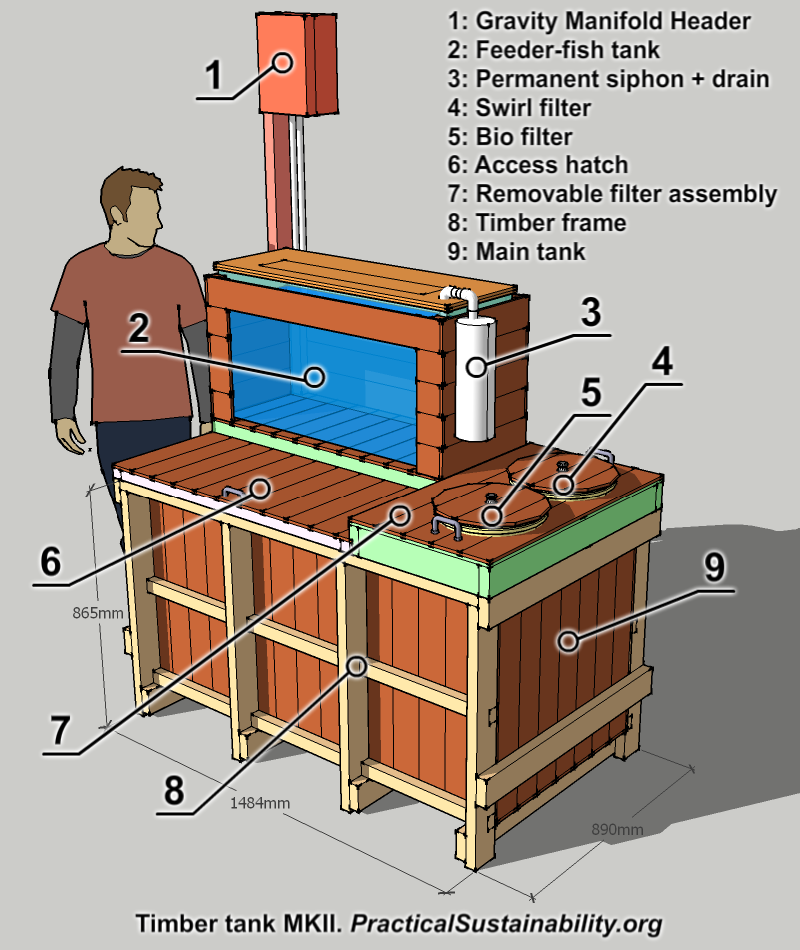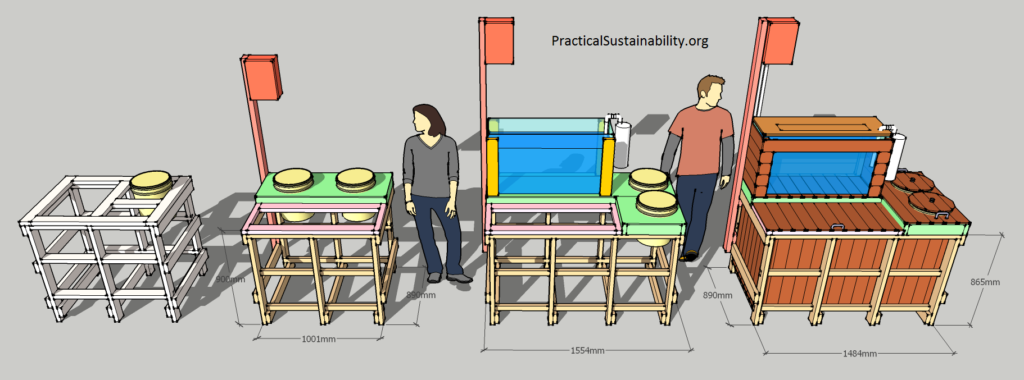The Nexus tank is a project to incorporate all previously built Aquaponic component prototypes into a single, compact, easily accessible unit. Grow beds are not included in these plans, but any style of grow bed can be attached to the system as long as it’s lower than the Header (1) and higher than the water level in the swirl filter (4). The maximum height of the Header (1) is only limited by the strength of the pump/s used in the main tank. Every element of this system has been built and tested successfully in previous projects. – Chris

1. Gravity Manifold Header
The gravity manifold header is designed to route water throughout the system at low pressures, driven by gravity. It also allows you to assign priorities to all outflow pipes, in case of pump failure or pressure reduction. No moving parts or valves of any kind. A basic version can be built for around $10-15. A Practical Sustainability creation.
Previous Builds:
- Oct 2014: MKI 1.5L Prototype. – Retired
- May 2015: MKII 2L 7x6mm, 2x8mm, prioritized flow, Manual start. (Click for article)
- Oct 2015: MKIII 5L 9x6mm, 1x8mm prioritized flow, Auto start. (Click for article)
2. Feeder fish tank
This tank is for breeding creatures that feed your large fish. Planned for snails and guppies, or any other creatures than can feed on detritus and raise the Trophic Level of biological waste or other food your large fish won’t enjoy. Integration of a feeder tank into an Aquaponic system cheaply, with no plumbing, is already fully tested. A 30-50mm gap between the tank and the timber housing will be left so insulation can be added. Further testing may extend to fresh water mussels and carnivorous fish when we can afford it.
- Oct 2014: 70L glass tank – Guppies, Yabby.
- Mar 2015: 100L glass tank – Guppies, snails. (Click for Image)
3. Permanent siphon, drains to ‘4’
Necessary to avoid piercing the glass tank. Multiple designs have been tested over the years, and the best ones needed maintenance (flushing) every 3-4 months. This new design will hopefully never need maintenance.
4. Swirl filter, drains to ‘5’
Basic DIY swirl filter. New designs will also be tested where all fittings and plumbing are on the bottom of the filter, so it looks neat but can still be pulled upwards and removed easily for maintenance. All external fittings will be plug and play.
- May 2015: Bucket Swirl filter (Click for article)
5. Bio filter, drains to ‘9’
- Basic DIY Bio-filter. Planned designs are an evolution of the originals. (Click for article)
6. Access hatch
Hinged access hatch, with optional fly-screen or other light permeable cover integrated for when the hatch is left open. Round Glass jar tops will be installed in the lid to provide daylight when the tank is shut.
7. Removable filter assembly
The support for the two filters will be 6-8mm ply clad with fence palings, so it can be removed as a single piece. Previous designs have proved the need for such removable sections, for both ease of access, and so alterations or repairs can be made to the filters and plumbing without spooking the fish.
8. Timber frame
9. Main tank
Tank walls will be made of 8-10mm fence palings, or other similar cheap timber. Tank lining will be two layers of cheap builders plastic, which remained watertight for years in two previous tank projects.

Thanks for reading! I’ll work on getting a Patreon page online to help fund this project. New Twitter account is up as of today @GreenPrototypes
-Chris

Thank you for providing the opportunity to learn aquaponics in this practical sustainability group